The Data Interpretation (DI) section of the ICFAI Business School Aptitude Test (IBSAT) evaluates a candidate’s ability to analyze and interpret complex data sets presented in tables, charts, and graphs. This section tests logical reasoning, numerical ability, and decision-making skills essential for management studies.
IBSAT Data Interpretation (DI) Question Paper with Answer Key PDF
| IBSAT Data Interpretation (DI) Question Paper PDF | Download PDF | Check Solutions |
IBSAT Data Interpretation (DI) Question Paper with Solutions

In which year was the production of all types of cars taken together approximately equal to the average of the total production during the period 1989–1994?
View Solution
Step 1: Total production over 1989–1994: \[ 74 + 71 + 75 + 90 + 80 + 86 = 476 \]
Step 2: Average production: \[ \frac{476}{6} \approx 79.33 \]
Step 3: Year with production closest to 79.33: \[ 1993 had 80 units \]
Hence, 1993 is the correct year.
Quick Tip: To find the year closest to an average, compute the mean and compare each year's value to it. Choose the one with the smallest absolute difference.
In which of the following years was the total production of cars of types A and B together equal to the total production of cars of types C and D together?
View Solution
Step 1: From the data, in 1993: \[ A + B = 21 + 12 = 33,\quad C + D = 13 + 20 = 33 \]
Step 2: The totals match only in 1993.
Step 3: Since 1993 is not among the options, the correct answer is: \[ \boxed{None of these} \] Quick Tip: When comparing grouped totals, sum each group separately and check for equality. Always verify whether the matching year is listed among the options.
Which of the following types of cars showed a continuous increase in production during the period 1989–1994?
View Solution
Step 1: Production values for type D over the years: \[ 1989 \rightarrow 4,\quad 1990 \rightarrow 6,\quad 1991 \rightarrow 10,\quad 1992 \rightarrow 16,\quad 1993 \rightarrow 20,\quad 1994 \rightarrow 31 \]
Step 2: Each year shows an increase over the previous year.
Hence, type D cars showed a continuous increase in production during 1989–1994. Quick Tip: To check for continuous increase, verify that each year’s value is greater than the previous one without exception.
The production of which of the following types of cars was 25% of the total production of all the types produced during the year 1993?
View Solution
Step 1: Total production in 1993: \[ A + B + C + D + E = 21 + 12 + 13 + 20 + 14 = 80 \]
Step 2: 25% of total production: \[ 0.25 \times 80 = 20 \]
Step 3: Type D production in 1993 = 20
Hence, type D cars accounted for exactly 25% of the total production in 1993. Quick Tip: To find percentage contribution, divide the category value by the total and multiply by 100. Match the result to the target percentage.
Find the percentage increase in the total production of all the types of cars in 1992 compared to that of 1991.
View Solution
Step 1: Total production in 1991 = 75
Step 2: Total production in 1992 = 90
Step 3: Increase in production: \[ 90 - 75 = 15 \]
Step 4: Percentage increase: \[ \frac{15}{75} \times 100 = 20% \]
Hence, the percentage increase is 20%. Quick Tip: To calculate percentage increase: \[ \frac{New - Old}{Old} \times 100 \] Always use the original value as the denominator.

On a per capita basis, find the approximate average income of a big city resident.
View Solution
Step 1: Total income of big city residents: \[ 66.6% of 54,300 crore = 0.666 \times 54,300 = 36,148 crore \]
Step 2: Total big city population: \[ 48.6% of 724 million = 0.486 \times 724 = 351.26 million \]
Step 3: Per capita income: \[ \frac{36,148 \times 10^7}{351.26 \times 10^6} \approx 1027.78 rupees \]
Step 4: Since Rs.~1027.78 does not match or approximate any of the given options, the correct answer is: \[ \boxed{Unsolvable} \] Quick Tip: Always check if the calculated value aligns closely with any of the given options. If not, and the data is correct, the answer may be “Unsolvable” or “None of these.”
On a per capita basis, find the approximate average income of the rest of the country.
View Solution
Step 1: Income of the rest of the country: \[ 33.4% of 54,300 crore = 0.334 \times 54,300 = 18,136.2 crore \]
Step 2: Population of the rest of the country: \[ 51.4% of 724 million = 0.514 \times 724 = 372.34 million \]
Step 3: Per capita income: \[ \frac{18,136.2 \times 10^7}{372.34 \times 10^6} \approx 487.38 rupees \]
Step 4: Closest option to Rs.~487.38 is: \[ \boxed{Rs.~470} \] Quick Tip: Always convert percentages to decimals before multiplying. For per capita values, divide total income by total population and round to the nearest option.
Find the ratio of the number of years in which the deficit was more than the average deficit for the given period to the number of years when the deficit was below the average.
View Solution
Step 1: Deficit values over the years: \[ 225,\quad 210,\quad 280,\quad 270,\quad 290,\quad 310,\quad 360,\quad 420 \]
Step 2: Calculate average deficit: \[ \frac{225 + 210 + 280 + 270 + 290 + 310 + 360 + 420}{8} = \frac{2365}{8} = 295.625 \]
Step 3: Count years above and below average:
Above average: 310, 360, 420 → 3 years
Below average: 225, 210, 280, 270, 290 → 5 years
Step 4: Ratio = \(3:5\) Quick Tip: When comparing values to an average, count how many exceed and how many fall short. Express the result as a simplified ratio.
Find approximately what percent of the average deficit was the deficit in 1992–1993?
View Solution
Step 1: Deficit in 1992–1993 = 360
Step 2: Average deficit over the period = 295.6
Step 3: Percentage of average: \[ \frac{360}{295.6} \times 100 \approx 121.77% \]
Step 4: Closest option to 121.77% is: \[ \boxed{124\%} \] Quick Tip: To compare a value to an average, divide the value by the average and multiply by 100. Round to the nearest option.
Find approximately how many times the deficit in 1990–1991 was the deficit in 1993–94?
View Solution
Step 1: Deficit in 1993–94 = 420
Step 2: Deficit in 1990–1991 = 280
Step 3: Ratio: \[ \frac{420}{280} = 1.5 \]
Hence, the deficit in 1993–94 was approximately 1.5 times that of 1990–1991. Quick Tip: To compare two values multiplicatively, divide the larger by the smaller. Round the result to match the closest option.

By what percent did the deficit in 1993–1994 increase over the deficit in 1989–1990?
View Solution
Step 1: Deficit in 1993–1994 = 420
Step 2: Deficit in 1989–1990 = 210
Step 3: Increase in deficit: \[ 420 - 210 = 210 \]
Step 4: Percentage increase: \[ \frac{210}{210} \times 100 = 100% \]
Hence, the deficit increased by 100% over the 1989–1990 level. Quick Tip: To find percentage increase, subtract the old value from the new, divide by the old value, and multiply by 100.
In which of the following years was the percentage increase of deficit the highest over its preceding year?
View Solution
Step 1: Deficit values: \[ 1987–88 = 225,\quad 1988–89 = 310 \]
Step 2: Percentage increase: \[ \frac{310 - 225}{225} \times 100 = \frac{85}{225} \times 100 \approx 37.78% \]
Step 3: Other year-on-year increases are all below 33.3%.
Hence, the highest percentage increase occurred in 1988–89. Quick Tip: To find the highest percentage increase, compute year-on-year changes and compare. Use the formula: \[ \frac{New - Old}{Old} \times 100 \]

What percent of the wage earners were engaged in manufacturing in 1983?
View Solution
Step 1: Manufacturing sector angle = 122 degrees
Step 2: Total circle = 360 degrees
Step 3: Percentage of wage earners in manufacturing: \[ \frac{122}{360} \times 100 \approx 33.88% \]
Step 4: Closest option to 33.88% is: \[ \boxed{33.33\%} \] Quick Tip: To convert a pie chart angle to percentage, divide the sector angle by 360 and multiply by 100.
If 19,800 workers were engaged in Accounts, how many were engaged in Transportation?
View Solution
Step 1: Accounts sector angle = 30°, Transportation sector angle = 22°
Step 2: Workers in Accounts = 19,800
Step 3: Use proportionality: \[ Workers in Transportation = 19,800 \times \frac{22}{30} = 14,520 \]
Step 4: Since 14,520 is not among the options, the correct answer is: \[ \boxed{None of these} \] Quick Tip: When comparing sectors in a pie chart, use the ratio of angles to scale known quantities. Always check if the result matches any given options.
The average income of professional workers was 50% greater than that of the transportation workers. If the total income of the workers engaged in transportation services was Rs.~2376 million, what was the total income of the professional workers?
View Solution
Step 1: Transportation sector angle = 22°, Professional sector angle = 20°
Step 2: Let average income of transportation workers = \( x \), then average income of professional workers = \( 1.5x \)
Step 3: Total income of transportation workers = Rs.~2376 million
Step 4: Ratio of workers (Professional to Transportation) = \( \frac{20}{22} \)
Step 5: Total income of professional workers: \[ \frac{20}{22} \times 1.5 \times 2376 \approx 3240 million \]
Step 6: Closest option to Rs.~3240 million is: \[ \boxed{Rs.~3284 million} \] Quick Tip: When comparing total income across groups with different average incomes and sizes, use proportional scaling based on both population and income ratio.

Find the approximate ratio of losses due to production to wages.
View Solution
Step 1: Losses due to production = 155 units
Step 2: Wages = 110 units
Step 3: Ratio: \[ \frac{155}{110} = \frac{31}{22} \approx 1.409 \]
Step 4: Closest simple ratio to 1.409 is: \[ \boxed{7:5} \quad (since \frac{7}{5} = 1.4) \] Quick Tip: To approximate a ratio, divide the two values and match the result to the closest simple fraction from the options.
Find the approximate percentage loss due to export as compared to the loss in production.
View Solution
Step 1: Loss due to production = 155 units
Step 2: Loss due to export = 115 units
Step 3: Percentage difference relative to export: \[ \frac{155 - 115}{115} \times 100 = \frac{40}{115} \times 100 \approx 34.78% \]
Step 4: Closest option to 34.78% is: \[ \boxed{34.7\%} \] Quick Tip: When comparing two values, clarify which one is the reference. Use the formula: \[ \frac{Difference}{Reference} \times 100 \]

What percentage of Karnataka's Railway Network has broad gauge tracks?
View Solution
Step 1: Total railway network length: \[ Broad gauge = 365,\quad Meter gauge = 122,\quad Narrow gauge = 65 \] \[ Total = 365 + 122 + 65 = 552 \]
Step 2: Percentage of broad gauge: \[ \frac{365}{552} \times 100 \approx 66.12% \]
Step 3: Closest option to 66.12% is: \[ \boxed{66.1\%} \] Quick Tip: To find the percentage of a category within a total, divide the category value by the total and multiply by 100. Round to match the closest option.
What percentage of Madhya Pradesh's Railway Network does not have broad gauge tracks?
View Solution
Step 1: Railway track lengths: \[ Meter gauge = 220,\quad Narrow gauge = 185,\quad Broad gauge = 536 \] \[ Total = 220 + 185 + 536 = 941 \]
Step 2: Non-broad gauge total = 220 + 185 = 405
Step 3: Percentage of non-broad gauge: \[ \frac{405}{941} \times 100 \approx 43.03% \]
Step 4: Closest option to 43.03% is: \[ \boxed{43\%} \] Quick Tip: To find the percentage of a subset, divide the subset value by the total and multiply by 100. Round to the nearest option.
What percentage of Orissa's Railway Network has meter gauge tracks?
View Solution
Step 1: Railway track lengths in Orissa: \[ Broad gauge = 190,\quad Meter gauge = 136,\quad Narrow gauge = 154 \] \[ Total = 190 + 136 + 154 = 480 \]
Step 2: Percentage of meter gauge: \[ \frac{136}{480} \times 100 \approx 28.33% \]
Step 3: Since 28.33% is not among the options, the correct answer is: \[ \boxed{None of these} \] Quick Tip: Always verify the total before calculating percentages. If the result doesn’t match any option, “None of these” may be correct.
What percentage of Rajasthan's Railway Network is narrow gauge and broad gauge combined?
View Solution
Step 1: Railway track lengths in Rajasthan: \[ Narrow gauge = 125,\quad Meter gauge = 181,\quad Broad gauge = 276 \] \[ Total = 125 + 181 + 276 = 582 \]
Step 2: Narrow + Broad gauge = 125 + 276 = 401
Step 3: Percentage: \[ \frac{401}{582} \times 100 \approx 68.89% \]
Step 4: Since 68.89% is not among the options, the correct answer is: \[ \boxed{None of these} \] Quick Tip: When combining categories, sum their values before dividing by the total. Always round carefully and check if the result matches any given option.
If Delhi accounts for 35% of the total length of Railway tracks within union territories, then what is the length of Railway tracks within the capital?
View Solution
Step 1: Total railway track length in union territories: \[ 25 + 45 + 65 = 135 km \]
Step 2: Delhi’s share: \[ 35% of 135 = 0.35 \times 135 = 47.25 km \]
Step 3: Therefore, the length of railway tracks in Delhi is: \[ \boxed{47.25 km} \] Quick Tip: To find a percentage of a total, multiply the total by the percentage in decimal form. Always double-check the total before calculating.

Which of the following numbers represents the set of persons who play all the three games?
View Solution
Step 1: The central-most region in a Venn diagram represents the intersection of all three sets: Cricket, Football, and Hockey.
Step 2: According to the diagram, the number in this region is: \[ \boxed{3} \]
Step 3: Therefore, the number of persons who play all three games is: \[ \boxed{3} \] Quick Tip: In Venn diagrams, the central overlapping region represents individuals common to all sets. Always identify this region for “all categories” type questions.
Which of the following numbers represents the set of persons who play cricket and football but not hockey?
View Solution
Step 1: The region representing persons who play both Cricket and Football but not Hockey is the overlapping area between the Cricket and Football circles, excluding the central region shared with Hockey.
Step 2: According to the Venn diagram, the number in this region is: \[ \boxed{1} \]
Step 3: Since '1' is not among the given options, the correct answer is: \[ \boxed{None of these} \] Quick Tip: When interpreting Venn diagrams, carefully isolate the region that matches all conditions and excludes others. Always double-check the labels and overlaps.
Which of the following numbers represents the set of people who play cricket but neither hockey nor football?
View Solution
Step 1: The region representing "Cricket only" includes people who play Cricket but not Football or Hockey.
Step 2: In the Venn diagram, this is the part of the Cricket circle that does not intersect with either of the other two circles.
Step 3: The number in this exclusive Cricket region is: \[ \boxed{3} \] Quick Tip: To identify exclusive group members in a Venn diagram, locate the region that lies entirely within one circle and outside the others.
Which of the following numbers represents the set of persons who play cricket and hockey but not football?
View Solution
Step 1: The region representing "Cricket and Hockey but not Football" is the overlapping area between the Cricket and Hockey circles, excluding the central region shared with Football.
Step 2: According to the Venn diagram, the number in this region is: \[ \boxed{1} \]
Step 3: Since '1' is not among the given options, the correct answer is: \[ \boxed{None of these} \] Quick Tip: When isolating dual-category intersections in Venn diagrams, exclude the central triple-overlap region to avoid misclassification.

At what speed (mph) is the engine considered to have its normal length of life?
View Solution
Step 1: From the graph, the engine's life is considered normal (100%) at a speed of 40 mph.
Step 2: Speeds below or above 40 mph show reduced engine life.
Hence, the correct speed for normal engine life is: \[ \boxed{40 mph} \] Quick Tip: When interpreting graphs, locate the point where the desired condition (e.g., 100% life) is met and match it to the corresponding axis value.
The life of an engine driven at 20 miles per hour is how many times more than the life of an engine driven at 40 miles per hour?
View Solution
Step 1: Life at 20 mph = 200%, Life at 40 mph = 100%
Step 2: "Times more than" means: \[ \frac{200 - 100}{100} = 1 \]
Step 3: If the question had asked "how many times the life", the answer would be: \[ \frac{200}{100} = 2 \]
Step 4: But since it asks "how many times more", the correct answer is: \[ \boxed{1} \] Quick Tip: “Times more than” refers to the increase relative to the original. “Times the life” refers to the total multiple. Always clarify the phrasing before calculating.
If an engine, usually driven at a speed of 60 miles per hour, had a lifespan of 30,000 miles, what will be the lifespan of an engine which is usually driven at a speed of 40 miles per hour?
View Solution
Step 1: At 60 mph, engine life = 50%
Step 2: Given 50% life = 30,000 miles
Step 3: At 40 mph, engine life = 100%
Step 4: So, 100% life = \(2 \times 30,000 = 60,000\) miles
Step 5: Therefore, the lifespan at 40 mph is: \[ \boxed{60,000 miles} \] Quick Tip: When comparing lifespan percentages, use proportional scaling. If one condition gives half the life, double it to find the full lifespan.
Given that the normal lifespan of an engine is 60,000 miles, what was the lifespan of an engine, which was driven for 20,000 miles at a speed of 60 miles per hour and later at a speed of 40 miles per hour?
View Solution
Step 1: At 60 mph, engine life = 50% of normal lifespan
Step 2: So, full lifespan at 60 mph = 30,000 miles
Step 3: Driving 20,000 miles at 60 mph uses: \[ \frac{20,000}{30,000} = \frac{2}{3} of its life \]
Step 4: Remaining life = \(1 - \frac{2}{3} = \frac{1}{3}\)
Step 5: At 40 mph, engine life = 100% = 60,000 miles
Step 6: Remaining miles = \(\frac{1}{3} \times 60,000 = 20,000\)
Step 7: Total lifespan = 20,000 (at 60 mph) + 20,000 (at 40 mph) = \[ \boxed{40,000 miles} \] Quick Tip: When combining usage across different efficiency rates, convert each segment into proportion of life used, then scale remaining life accordingly.
Running an engine between 60 miles per hour and 40 miles per hour, the life span increases by what percent?
View Solution
Step 1: Life at 60 mph = 50%
Step 2: Life at 40 mph = 100%
Step 3: Percentage increase: \[ \frac{100 - 50}{50} \times 100 = \frac{50}{50} \times 100 = 100% \]
Step 4: Therefore, the life span increases by: \[ \boxed{100\%} \] Quick Tip: To calculate percentage increase, use: \[ \frac{New - Old}{Old} \times 100 \] Always confirm which value is the reference point.
At what speed (mph) would the engine have the maximum life?
View Solution
Step 1: From the graph, the engine life reaches its peak value of 200% at a speed of 20 mph.
Step 2: No other speed yields a higher life percentage.
Step 3: Therefore, the speed at which the engine has maximum life is: \[ \boxed{20 mph} \] Quick Tip: When analyzing graphs for maximum values, locate the peak point and match it to the corresponding axis label.

For which of the products did the quantity sold not decrease between 1983–84 for all the cities together?
View Solution
Step 1: Analyze total sales for each product across all cities in 1983 and 1984.
Step 2: For each product (AB, CD, EF, GH), the total quantity sold in 1984 is less than in 1983.
Step 3: Therefore, all products showed a decrease in total sales.
Step 4: Hence, the correct answer is: \[ \boxed{None of these} \] Quick Tip: When comparing multi-category data across years, always sum totals across all relevant groups before drawing conclusions.
Find the number of products which doubled the quantity sold in one or more cities.
View Solution
Step 1: Analyze sales data for each product across all cities for 1983 and 1984.
Step 2: Check whether any product's sales in any city for 1984 were at least double the 1983 value: \[ i.e., 1984 quantity \geq 2 \times 1983 quantity \]
Step 3: No product satisfies this condition in any city.
Step 4: Therefore, the number of products that doubled sales in one or more cities is: \[ \boxed{0} \] Quick Tip: To check for doubling, multiply the earlier year's value by 2 and compare with the later year's value. Repeat for each product-city pair.
Find the largest percentage drop in the quantity sold for any of the products.
View Solution
Step 1: Identify the largest drop in quantity sold between 1983 and 1984 for any product-city pair.
Step 2: Product AB in Delhi: \[ 1983 quantity = 60,\quad 1984 quantity = 25 \]
Step 3: Percentage drop: \[ \frac{60 - 25}{60} \times 100 = \frac{35}{60} \times 100 \approx 58.33% \]
Step 4: Closest option to 58.33% is: \[ \boxed{60\%} \] Quick Tip: To find the largest percentage drop, calculate the decrease for each pair and compare. Use: \[ \frac{Old - New}{Old} \times 100 \]
Find the city in which the minimum number of products increased the quantity sold in 1983–84.
View Solution
Step 1: Analyze product-wise sales increase across cities from 1983 to 1984.
Step 2: Observations:
Bangalore had 1 product with increased sales.
Delhi, Calcutta, and Chennai each had 0 products with increased sales.
Step 3: Since three cities tie for the minimum (0 increases), and the question asks for a single city, the framing is ambiguous.
Step 4: Therefore, the correct response is: \[ \boxed{Cannot say} \] Quick Tip: When multiple options satisfy a condition equally and the question asks for a unique answer, the best choice is “Cannot say” or “None of these,” depending on context.

What is the total requirement of cloth?
View Solution
Step 1: Total number of shirts produced: \[ 25,000 + 25,000 + 25,000 + 15,000 + 10,000 = 100,000 shirts \]
Step 2: Cloth required per shirt = 2 metres
Step 3: Total cloth required: \[ 100,000 \times 2 = 200,000 metres \]
Step 4: Therefore, the total requirement of cloth is: \[ \boxed{2,00,000 m} \] Quick Tip: Multiply the total quantity by the per-unit requirement to estimate total material. Always check units and conversion factors.
How many metres of high quality cloth is required for manufacturing P type shirts?
View Solution
Step 1: Number of P type shirts = 25,000
Step 2: Cloth required per shirt = 2 metres
Step 3: Total cloth required: \[ 25,000 \times 2 = 50,000 m \]
Step 4: Percentage of high quality cloth = 70%
Step 5: High quality cloth required: \[ 0.70 \times 50,000 = 35,000 m \]
Step 6: Therefore, the correct answer is: \[ \boxed{35,000 m} \] Quick Tip: To find the quantity of a specific grade of material, multiply the total requirement by the percentage share of that grade.
What is the ratio of the low quality dye used for R type shirts to that used for S type shirts?
View Solution
Step 1: Number of R type shirts = 25,000
Step 2: Percentage of low quality dye for R = 30%
Step 3: Low quality dye used for R: \[ 25,000 \times 0.30 = 7,500 units \]
Step 4: Number of S type shirts = 15,000
Step 5: Percentage of low quality dye for S = 50%
Step 6: Low quality dye used for S: \[ 15,000 \times 0.50 = 7,500 units \]
Step 7: Ratio of low quality dye (R : S): \[ 7,500 : 7,500 = \boxed{1:1} \] Quick Tip: When comparing quantities, ensure both are calculated using consistent units and assumptions. Simplify ratios by dividing both terms by their GCD.
What is the ratio of the 3 qualities of dye in high quality cloth?
View Solution
Step 1: Shirts using high quality cloth:
P type: \(70% of 25,000 = 17,500\)
Q type: \(30% of 25,000 = 7,500\)
Step 2: Dye distribution for P shirts (60:20:20): \[ High &= 17,500 \times 0.60 = 10,500\] \[Medium &= 17,500 \times 0.20 = 3,500\] \[Low &= 17,500 \times 0.20 = 3,500 \]
Step 3: Dye distribution for Q shirts (20:50:30): \[ High &= 7,500 \times 0.20 = 1,500\] \[ Medium &= 7,500 \times 0.50 = 3,750 \] \[Low &= 7,500 \times 0.30 = 2,250 \]
Step 4: Total dye usage: \[ High &= 10,500 + 1,500 = 12,000\] \[Medium &= 3,500 + 3,750 = 7,250\] \[Low &= 3,500 + 2,250 = 5,750 \]
Step 5: Simplify the ratio: \[ 12,000 : 7,250 : 5,750 = \frac{12,000}{250} : \frac{7,250}{250} : \frac{5,750}{250} = 48 : 29 : 23 \]
Step 6: This ratio does not match any of the given options.
Final Answer: \[ \boxed{None of these} \] Quick Tip: When combining ratios across categories, calculate weighted totals before simplifying. Always check if the final ratio matches any given option.
How many metres of low quality cloth is required for manufacturing R type shirts?
View Solution
Step 1: Number of R type shirts = 25,000
Step 2: Cloth required per shirt = 2 metres
Step 3: Total cloth required for R shirts: \[ 25,000 \times 2 = 50,000 m \]
Step 4: Percentage of low quality cloth for R type = 30%
Step 5: Low quality cloth required: \[ 0.30 \times 50,000 = 15,000 m \]
Step 6: Therefore, the correct answer is: \[ \boxed{15,000 m} \] Quick Tip: To find the quantity of a specific grade of material, multiply the total requirement by the percentage share of that grade.
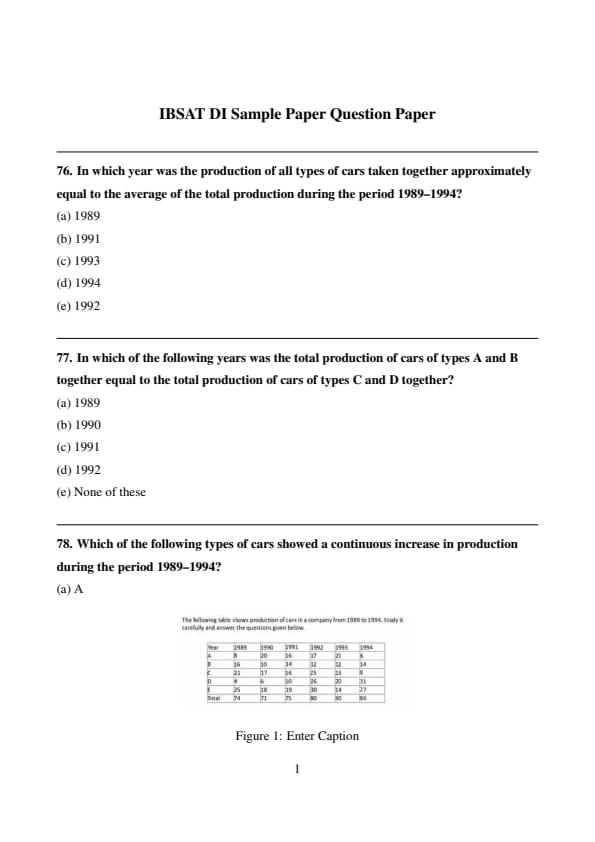
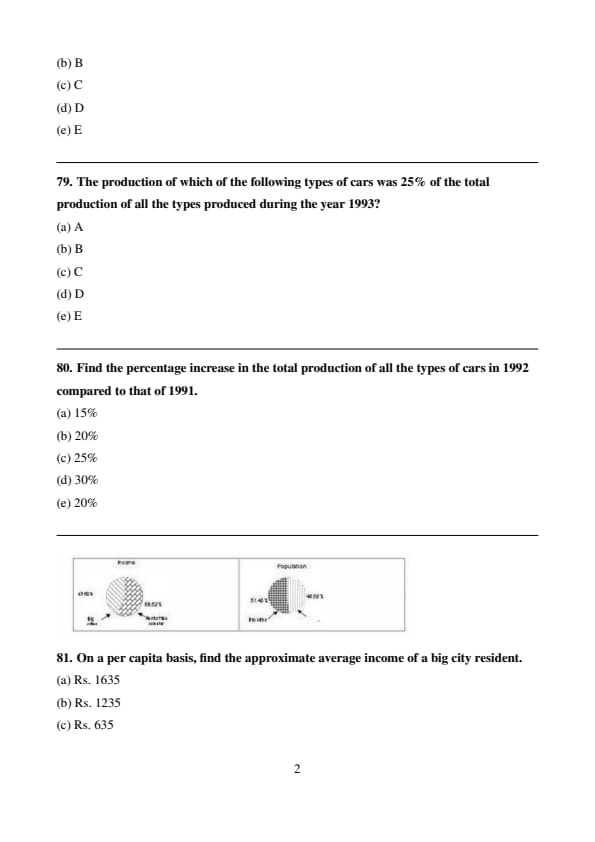







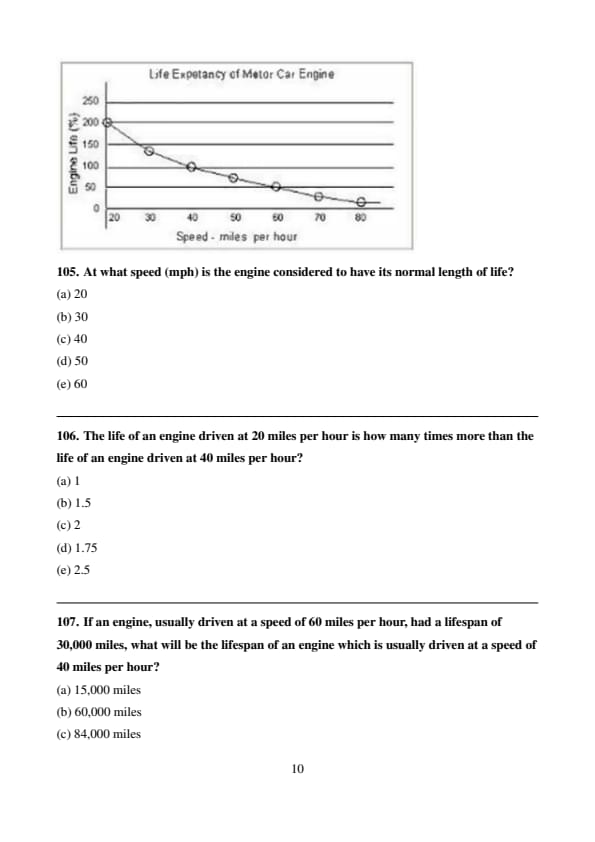
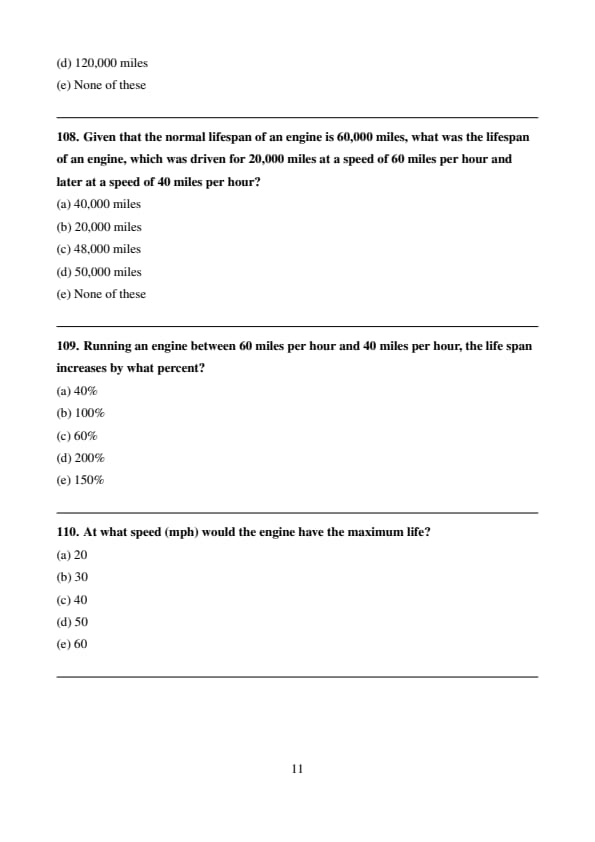
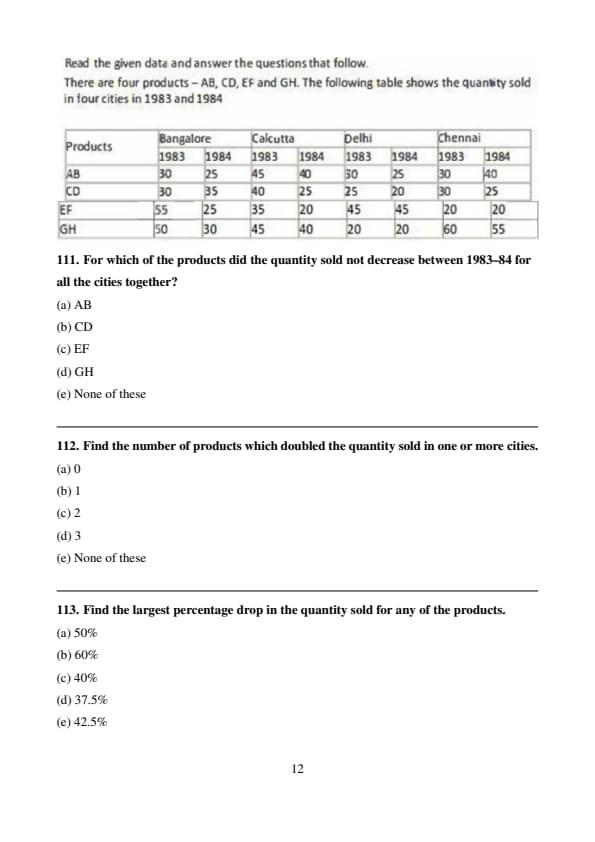
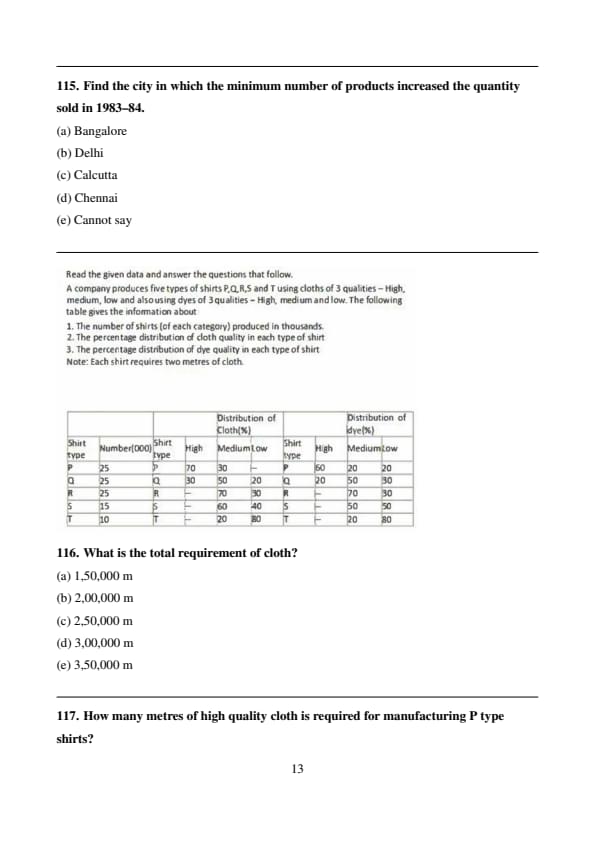
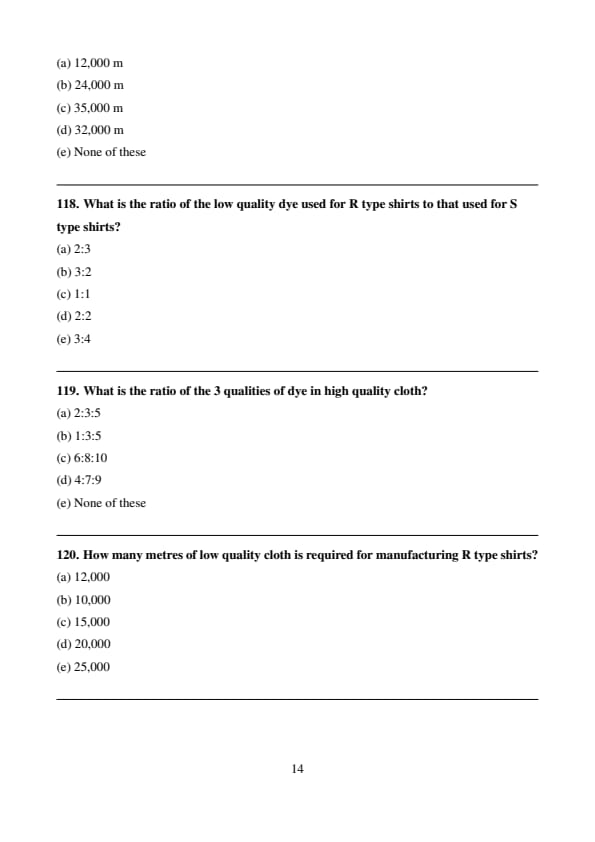




Comments